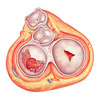Mosby 14 Flashcards
(139 cards)
Position of heart with respect to costal cartilages
3rd to 6th
The area overlying heart
Precordium
Upper portion of heart
Lower portion of heart
Base
Apex
Relationship of heart position to tallness
The more tall the more central/vertical vs. left/horizontal
Mirror image heart (right)
Dextrocardia
Somach and heart on right side
Sinus inversus
Apical pulse of left ventricle position
5th intercostal space @ midclavicular line
Infancy
Size of left/right atrium
Extra connections
Arrangement of heart
Equal unlike adult
ductus arterisus, foramen ovale
More horiztonal than adults
Pregnancy
Change in blood volume
Which part
When start/edn
Heart position change
Increases 50%
Plasma
Starting in first timester and peaking in 30th week, 3-4wks after delivery
Rotations towards horizontal axis
Hemodynamic Changes during pregnancy

Pressure or choking sensation substernally or into the neck
Cause?
Angina
strenuous physical activity, eating, exposure to intense cold, windy weather, or exposure to
emotional stress
sudden, sharp, relatively brief pain that does not radiate, occurs most often at rest, and is unrelated to exertion and may not have a discoverable cause
precordial catch
Ddx for chest pain
Cardiac
• Typical angina pectoris
• Atypical angina pectoris, angina equivalent
• Prinzmetal variant angina
• Unstable angina (acute coronary syndrome)
• Coronary insufficiency
• Myocardial infarction
• Nonobstructive, nonspastic angina
• Mitral valve prolapse
Aortic
• Dissection of the aorta
Pleuropericardial Pain
• Pericarditis
• Pleurisy
• Pneumothorax
• Mediastinal emphysema
Gastrointestinal Disease
• Hiatus hernia
• Reflux esophagitis
• Esophageal rupture
• Esophageal spasm
• Cholecystitis
• Peptic ulcer disease
• Pancreatitis
Pulmonary Disease
• Pulmonary hypertension
• Pneumonia
• Pulmonary embolus
• Bronchial hyperreactivity
• Tension pneumothorax
Musculoskeletal
• Cervical radiculopathy
• Shoulder disorder or dysfunction (e.g., arthritis, bursitis, rotator cuff injury, biceps tendonitis)
• Costochondral disorder
• Xiphodynia
Psychoneurotic
• Illicit drug use (e.g., cocaine)
Anginal pain
Characteristic
Substernal; provoked by effort, emotion, eating; relieved by rest
and/or nitroglycerin; often accompanied by diaphoresis,
occasionally by nausea
Pleural pain
Characteristic
Precipitated by breathing or coughing; usually described as
sharp; present during respiration; absent when breath held
Esophageal Pain
characteristics
Burning, substernal, occasional radiation to the shoulder;
nocturnal occurrence, usually when lying flat; relief with food,
antacids, sometimes nitroglycerin
Pain from a peptic ulcer
characteristics
Almost always infradiaphragmatic and epigastric; nocturnal
occurrence and daytime attacks relieved by food; unrelated
to activity
Biliary pain
characteristics
Usually under right scapula, prolonged in duration; often
occurring after eating; will trigger angina more often than
mimic it
Arthritis/bursitis
characteristics
Usually lasts for hours; local tenderness and/or pain with
movement
Cervical pain
characteristics
Associated with injury; provoked by activity, persists after
activity; painful on palpation and/or movement
Musculoskeletal (chest) pain
characteristics
Intensified or provoked by movement, particularly twisting or
costochondral bending; long lasting; often associated with
focal tenderness
Psychoneurotic pain
characteristics
Associated with/after anxiety; poorly described; located in intramammary region
DDx comparison
Angina pectoris
muscoskeletal
gastrointestinal

HPI Chest pain description: onset and duration
sudden, gradual, or vague onset, length of episode; cyclic nature;
related to physical exertion, rest, emotional experience, eating, coughing, cold temperatures,
trauma, awakens from sleep




































